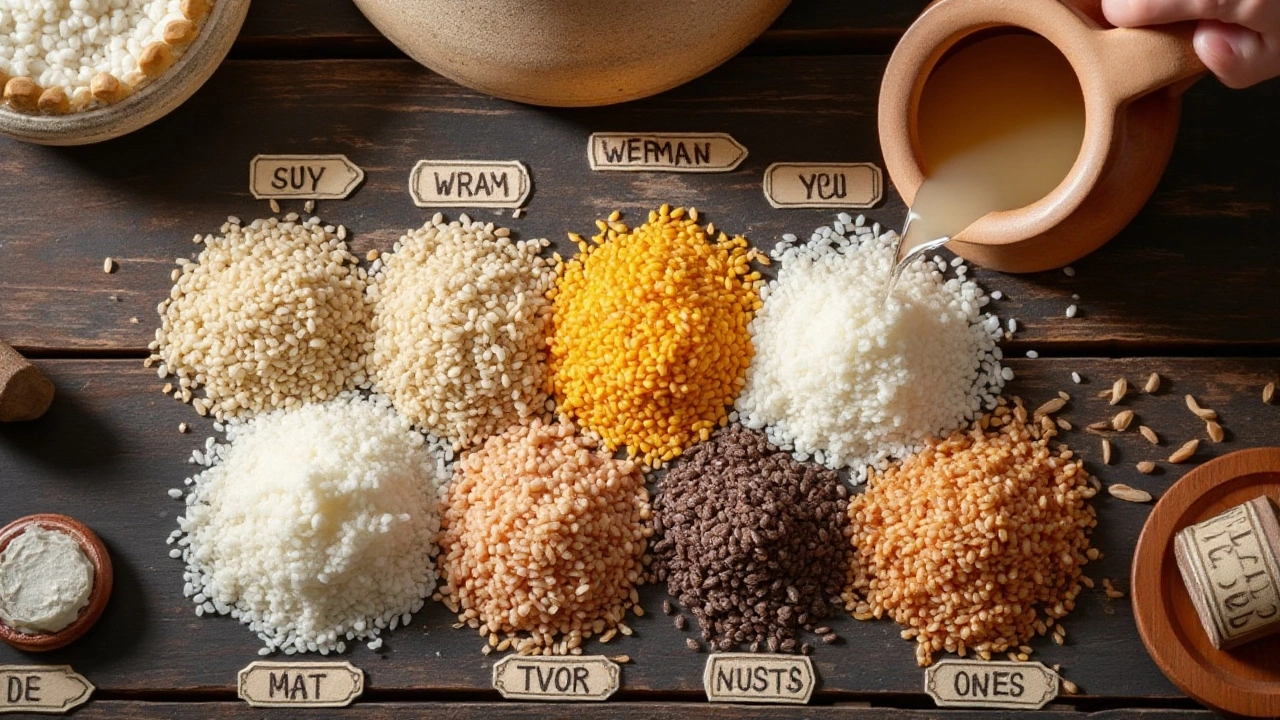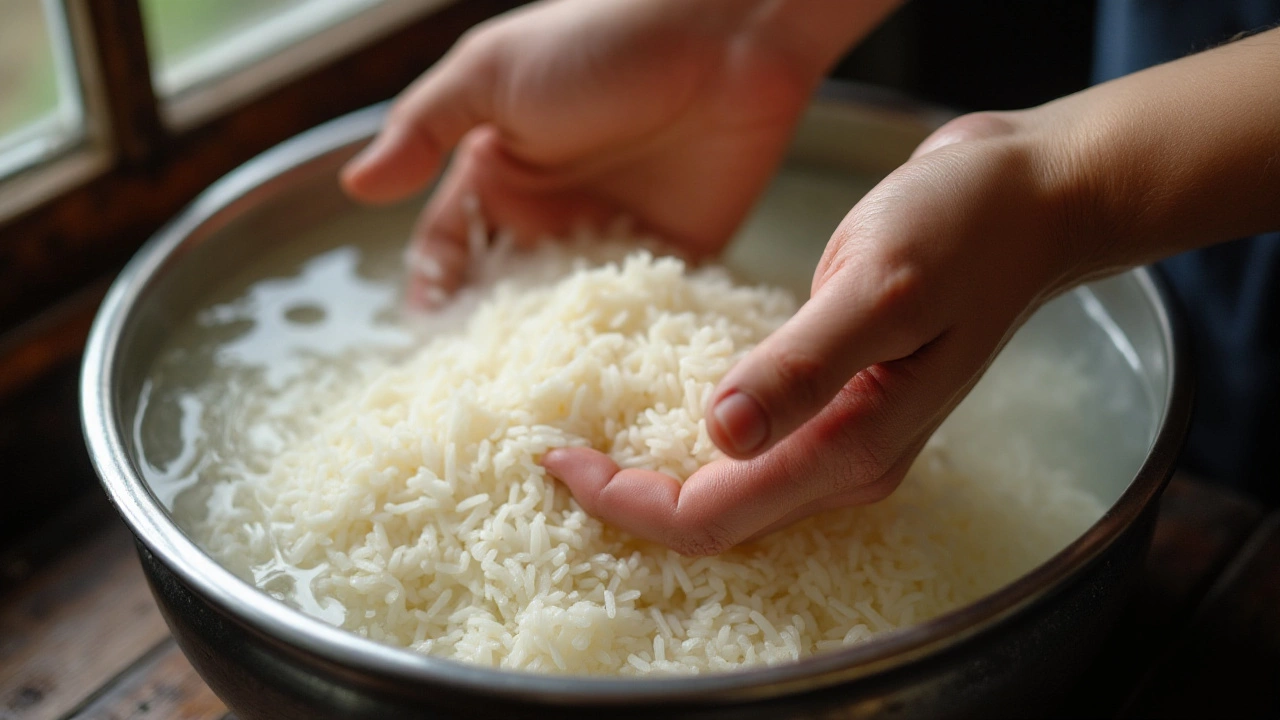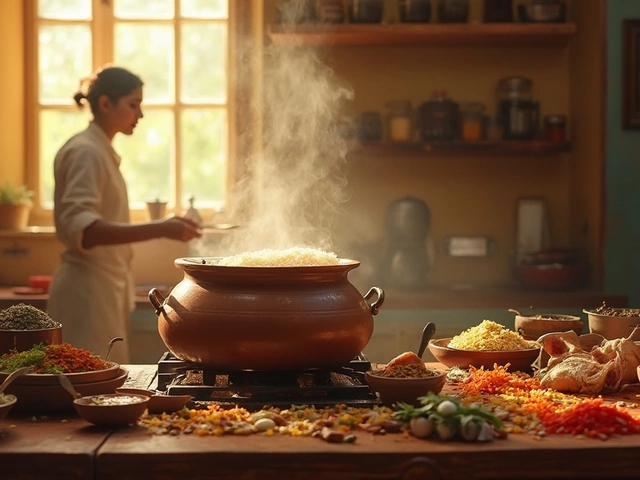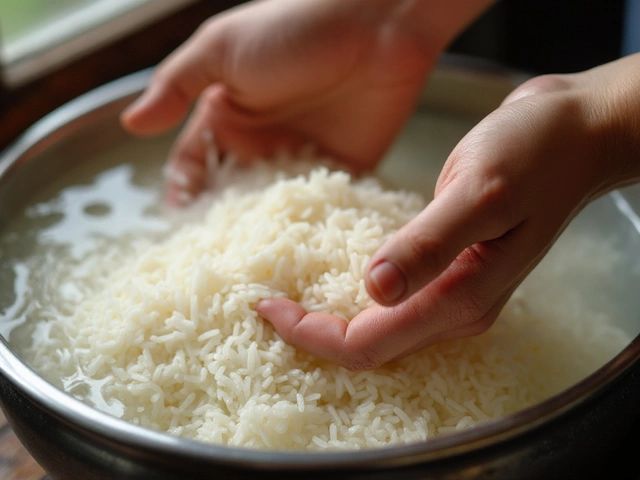The simple act of washing rice before cooking goes beyond just a rinse. Whether it’s a generational tradition or a newfound habit, this step is about elevating quality and safety. As the water runs clear, what appears to be an insignificant task is actually the start of a transformation. From clearing unwanted starch that may cause clumping, to removing dust and residues that might remain from farming, washing marks the transition from raw ingredient to a staple ready to shine.
Let's unravel the reasons and methods behind this practice, so each grain that dances in the pot does so to perfection. Be it jasmine, basmati or sushi rice, understanding the essence of washing will enhance your cooking adventures.
- Understanding Rice Cultivation
- The Role of Starch in Rice
- Rinsing Away the Residue
- Techniques for Washing Rice
- Benefits Beyond the Surface
- Tips for Perfect Rice Preparation
Understanding Rice Cultivation
One of the oldest known grains, rice has been cultivated for thousands of years. This humble yet globally essential crop begins its journey in the warm plains and intricate terraces of Asia. It's a plant that thrives in flooded conditions, primarily in an environment of monsoonal climates. The rice cultivation process is a marvel of agricultural engineering, with its roots deeply embedded in the cultural practices of regions where rice isn't just food, but also a way of life. From sowing to harvesting, the journey of rice is dotted with meticulous traditions and innovations.
The cultivation process starts with selecting the right type of paddy seeds suited to the climate and soil conditions. These seeds are then sprouted in water-laden fields to generate seedlings, which are transferred to flooded paddies. The control of water in rice paddies, often done by ancient yet effective methods, is crucial as it helps weed control and provides the necessary space for the rice to grow tall and healthy. Few examples show human ingenuity and adaptation to nature better than these rice terraces cradled on mountainsides, evident in iconic landscapes like those seen in the Philippines' Banaue Rice Terraces.
As Matt Fielding, a renowned agricultural historian, once said, "The resilience of rice farmers is mirrored in the grains they harvest, enduring seasons yet always thriving." During the growing season, water management is critical. Farmers ensure that water is maintained at optimal levels due to its dual role in growth promotion and pest management. As the plants mature, the harvested paddy undergoes various stages of drying and milling. The husk is removed to reveal the familiar rice grains we consume. This process not only determines the rice's quality but also its value in the market.
In recent years, technological advancements and sustainable practices have further shaped rice cultivation. Many farmers are now integrating methods that reduce water usage and minimize environmental impact, such as the System of Rice Intensification (SRI), which aims to produce more grains with fewer resources. This method has significantly influenced rice farming, promoting healthier and more productive plants through smarter farming techniques. Understanding these complexities is key to recognizing why practices like washing rice before cooking are not only traditional but also practical, ensuring cleaner, better-tasting grains.
The Role of Starch in Rice
In the grand tapestry of cooking, even the most mundane elements like starch play critical roles, especially when it comes to rice preparation. Starch, a carbohydrate found in abundance in rice, is responsible for many of the textural qualities cherished by rice lovers around the world. When raw, rice grains are tightly packed with this complex sugar, which affects how they behave during the cooking process. As rice cooks, the starches begin to gelatinize, absorbing water and swelling, which can result in grains that cling together in a chewy mass if not handled properly.
This tendency to stick is where the significance of washing rice comes in. Rinsing rice removes the surface starch that can become gooey when heated. The sleek grains characteristic of perfectly cooked rice often owe their definition to thorough rinsing. Ignoring this step could lead to a gummy and less appetizing outcome. It is especially crucial for lighter rice varieties such as basmati or jasmine, where flavor subtleties and individual grain separation are paramount.
Not all starch is a nuisance, however. Sweet or sticky rice varieties benefit from retaining some of their natural starches, creating the beloved adhesiveness in dishes like sushi or rice cakes. Balancing the right amount of starch involves understanding both the rice type and desired dish outcome. According to Harold McGee, one of the gurus in food science, "Rinsing makes a bigger difference in certain rice varieties, but you'll usually see improvements in taste and texture with any type by rinsing away excess starch, even just under running water."
"Rinsing makes a bigger difference in certain rice varieties, but you'll usually see improvements in taste and texture with any type by rinsing away excess starch, even just under running water." - Harold McGee
An intriguing aspect of starch is its influence on the glycemic index of rice. Recent data suggest that rinsing rice can slightly reduce the glycemic index, as some soluble starches get washed away. This can make a modest impact on how rice is absorbed and metabolized by the body, offering a slightly "healthier" option for those mindful of their sugar intake. However, the most substantial change remains in the sensory experience, where rinsing dictates how rice looks, feels, and, to some extent, tastes. A simple act that speaks volumes through every spoonful, marrying tradition and science seamlessly.

Rinsing Away the Residue
There’s more than meets the eye when it comes to the reasons we wash rice before cooking. The prominent factor, of course, is the removal of excess starch, which can significantly impact the rice’s cooking and flavoring profile. When rice is harvested, transported, and finally shelled out in the markets, it carries along a powdered coating — a relic of its journey from paddy to plate. This starchy powder can cause rice to become glue-like or stodgy if not washed away before cooking.
Washing rice properly also assists in getting rid of dirt and contaminants that may have accumulated within the process of rice preparation. Although modern processing techniques have improved, it is possible for residues from pesticides or other substances to remain. The Japanese have perfect the art of rice washing over centuries, often advocating the importance of attention and detail in care associated with cleaning rice grains.
In a famous conversation with a culinary magazine, Chef Nobu Matsuhisa noted, "Rice washing symbolizes removing the bad fortunes from the rice, leaving only prosperity." Indeed, in many cultures, rice plays not just a culinary role, but a symbolic one, and the act of washing is as much ritualistic as it is functional.
Not all rice varieties require the same level of washing. Short grain rice, often used in sushi, can be particularly starchy, making rinsing more critical. On the other hand, certain types of clean rice cooking like Arborio for risotto are typically used with some starch intact to aid in creating a creamy texture. Given this, it's imperative to understand what your end dish requires.
Rinsing Techniques
Rinsing techniques can vary, but the general rule of thumb is to rinse until the water runs clear. This process is most easily achieved through the use of a fine mesh sieve or bowl, gently swirling the rice with your fingers under cool running water. It’s recommended to rinse at least two to three times. For those who prefer tradition, some experts suggest soaking the rice for 30 minutes after washing, to further ensure clarity and purity.
| Rice Type | Recommended Rinse Cycles |
|---|---|
| Short Grain (e.g., Sushi Rice) | 3-4 |
| Medium Grain (e.g., Basmati) | 2-3 |
| Long Grain (e.g., Jasmine) | 1-2 |
It is fascinating to see how such a seemingly mundane act of rice washing tips contributes not just to culinary success, but also connects us across cultures through its shared history and wisdom. By taking the extra step to rinse your rice, you embrace this timeless culinary wisdom, ensuring a bowl of perfect, non-clumpy grains every time.
Techniques for Washing Rice
In the ritual of cooking, washing rice is a delicate dance between tradition and science. This task, often underestimated, is quite crucial. Whether you're preparing a basic batch of white rice or diving into a more complex dish with clean rice cooking in mind, knowing how to properly wash your rice ensures the best output. The art of washing rice entails more than a single rinse. To kick things off, place the rice in a large bowl, allowing you enough room to work. Add plenty of water above the rice level, and with both hands, dive in as if you're gently cradling the grains. By massaging them with your fingers, you aid in dislodging surface starch and dust, which could otherwise lead to sticky rice if not removed.
Next, drain this milky water—which now carries away impurities—and repeat the process. But how many times should you actually wash your rice? There’s no universal answer; it largely depends on the type of rice and its end use. Many chefs recommend rinsing until the water runs clear, a sign that most of the surface starch is gone. This could mean 3 to 5 washes for rice washing tips to be truly effective. For sticky rice varieties, a bit of starch retention is desirable, so fewer rinses might suffice. A common rule is to go by sight and feel, rather than a strict count.
"When dealing with rice, it’s the grain you've not paid attention to that can be the game changer," chef Morimoto once shared, emphasizing the importance of proper cleaning techniques.
Once your rice is prepped and ready, there's one more step before it meets the heat: a soak. Particularly with types like jasmine or basmati, soaking enhances the texture of the final product. By allowing the grains to absorb water before cooking, you not only improve the aroma but also the elasticity of each grain. In terms of temperature, using cold water for these processes avoids starting the cooking prematurely. It's important to mention that this lends itself to more uniform texture once on the stove.
For those seeking precision, this meticulous process has been captured in statistics by culinary experts. Consider the Japanese technique, which adds a pinch of salt to each wash to aid in exfoliating the grains. This method reports a 10% improvement in texture, as experienced by testers. Such detailed tricks often make the notable difference between else ordinary rice and perfect rice preparation.
If there's a takeaway from this age-old technique, it's the artful balance between the practical and intuitive. Even as you immerse yourself in this task, the feel of the water, the resistance of the grains, all come together to guide you. Like any skill, practice refines the touch, turning a simple household chore into a respected craft.

Benefits Beyond the Surface
When we think of washing rice before cooking, it might seem like we are simply making sure our ingredients are clean, but the benefits truly run deeper. One of the most significant advantages of rinsing rice is the removal of excess starch. This is particularly notable in short-grain rice varieties such as sushi rice, which when cooked, can become overly sticky and may lead to clumping. By washing, you can ensure a fluffier texture every time. This is crucial if you're aiming for rice dishes where each grain stands free, such as in fried rice. A practical aspect of washing rice also includes the removal of any remaining pesticides or chemicals that might have been used during cultivation. Even though washing doesn't completely eliminate all remnants, it significantly reduces their presence, which is a simple step towards healthier cooking. Additionally, washing the rice can remove dust or small particles trapped during the packaging process. This is not only about culinary precision; it's about making sure what you serve is clean and pure. In some cultures, such as in Japan, where rice holds a significant place in the diet, washing rice is not just a culinary step; it's steeped in ritual and respect for the food.
From a nutritional standpoint, while washing does remove a minimal amount of nutrients, the trade-off for cleaner grains is usually more appreciated. According to Harold McGee, a respected food scientist, "The ritual of washing rice has less to do with sanitation, and more to do with preparing the grain for heating, just as we preheat ovens before baking." Rice preparation through washing is essential across various cooking traditions worldwide because it sets the stage for more even cooking. This routine clearly shows appreciation for the ingredient, as it enhances flavor absorption in dishes where rice needs to soak in broths or sauces. This extra touch can very much distinguish between a flat dish and an exquisitely prepared culinary piece. All in all, the act of washing rice before cooking plays a vital role in enhancing the flavor, texture, and safety of your meal. Why skip such a simple, yet beneficial step?
Tips for Perfect Rice Preparation
Crafting the perfect rice dish can seem like a culinary mystery to some, but with a bit of understanding and a dash of patience, it’s a journey anyone can master. The secret lies in a combination of technique and quality ingredients. Start by opting for high-quality rice varieties that suit the dish you are preparing, be it the fragrant jasmine for Southeast Asian dishes or the robust basmati for Indian fares. Always, without skipping, rinse the rice grains under cold water until the water runs clear, a crucial step for removing starch, dust, and any residues. This practice aids in achieving fluffier, non-sticky rice. It’s not just an extra step; it's imperative for that perfect texture.
Once washed, it's time to consider your cooking method, which can vary dramatically based on the type of rice and cuisine. Whether using a rice cooker, stovetop, or microwave, each method has its own unique way of influencing the rice’s texture and flavor. For those who enjoy experimenting, try soaking the rice before cooking. This approach can cut down on cooking time and make the grains softer and tender. The ratio of rice to water also plays a critical role—it can make all the difference between a pot of mushy rice and one that is perfectly cooked. As a rule of thumb, for every cup of white rice, use about one and a half cups of water, tweaking according to rice type and personal preference.
An often overlooked aspect of rice preparation is seasoning. Infusing the rice with flavors by adding ingredients like a pinch of salt, a bay leaf, or a couple of cardamom pods while cooking can elevate a simple dish into a fragrant treasure. Some chefs swear by the aromatics. As the rice steams, the subtle scents are absorbed, offering a delightful surprise in each bite.
"Cooking rice is like writing a melody," notes culinary expert Chef Ming Tsai, "the more layers you add, the deeper it resonates."Taking the time to allow the rice to rest after cooking—a mere ten minutes left alone in the pot—is yet another step. This critical pause allows the steam to work its magic, enhancing texture and making the rice just right for serving.
To round off, pay attention to the environment in which you store rice before and after cooking. Store uncooked rice in a cool, dry place to prevent spoilage. For those who often have leftovers, keep cooked rice in an airtight container in the refrigerator, where it remains good for up to five days. When reheating, add a spoonful of water to restore moisture—a little trick that retains that freshly cooked texture. By adhering to these steps, you ensure each meal with rice is memorable, comforting, and delicious. Perfect rice preparation is an art, and with the right tips, anyone can become an artist.



